Lillian Michelson has helped guide some of the brightest filmmakers through her work as a hollywood archivist and librarian. She’s a certifiable behind-the-scenes legend and calls MPTF home.
Watch Lillian’s story, performed by Alessandro Nivola (Face/Off, American Hustle) and Mira Sorvino (Mighty Aphrodite, Mimic) and written by John Hoffman (Looking), below. You can also read the full text from the script below the video.
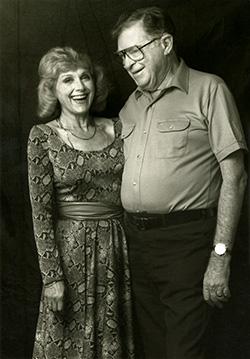 Francis Ford Coppola once said “a number of images put together a certain way become something above and beyond what any of them are individually.” The same could be said for a relationship. All the individual moments shared, if you’re as lucky as Harold and Lillian Michelson, for over sixty years–can take on even bigger meaning when put together in a certain way. It’s all about your view and perspective on those moments.
Francis Ford Coppola once said “a number of images put together a certain way become something above and beyond what any of them are individually.” The same could be said for a relationship. All the individual moments shared, if you’re as lucky as Harold and Lillian Michelson, for over sixty years–can take on even bigger meaning when put together in a certain way. It’s all about your view and perspective on those moments.
If you happened to be a bombardier navigator in World War II, like Harold, it meant you had quite a view–tucked into the turret of a plane, trying to focus on your job and not the lives forever impacted by how you interpret that view. Harold thought of getting back home, to his family–and to his sister’s best friend, who he used to love to make fun of, even though she was the smartest person he’d ever met.
If you happened to be a young girl around that time, living outside Miami in one of the orphanages you’d been forced to grow up in, like Lillian, you might choose to escape the world by diving into Grimm’s Fairy Tales — and stories of fantasy kingdoms that ended with a “happily ever after” you didn’t dare dream of for yourself. Lillian focused on becoming spelling bee champion and time with her best friend–thinking only of her friend’s brother as that guy who was off at war, who always loved to comment on all of her flaws.
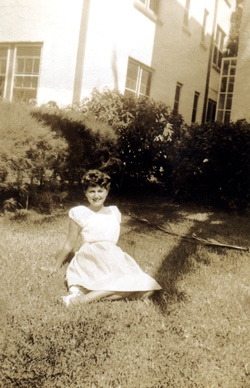 Then Harold came home–and all he saw was Lillian. Lillian knew that an orphan wasn’t what his mother had in mind for her son. She wanted a Miami heiress–a princess for her “prince.” But, in the war, Harold had become enamored with one other thing–illustration. Once Lillian saw the way Harold could draw, and saw the way he loved it, she saw his future. “A life doing what you love? What could be better than that? Your career is to be an artist.”
Then Harold came home–and all he saw was Lillian. Lillian knew that an orphan wasn’t what his mother had in mind for her son. She wanted a Miami heiress–a princess for her “prince.” But, in the war, Harold had become enamored with one other thing–illustration. Once Lillian saw the way Harold could draw, and saw the way he loved it, she saw his future. “A life doing what you love? What could be better than that? Your career is to be an artist.”
Harold took Lillian to a make-out place in Palm Beach where they sat under the moon and he asked her, “What color do you want to paint our front door?” Lillian still couldn’t take it in–what about all of his nasty comments about her growing up? Harold told her, “well, you don’t look like that anymore–and the truth is I loved you back then. I loved you when you were in your ugly stage.” Lillian accepted Harold’s invite to move to Los Angeles and then his proposal of marriage. After struggling to find work and living on less than a shoestring, Harold became an illustrator for films. To say what an illustrator–or storyboard artist, as Harold soon came to be–can do for a film is really pointless, because the pictures tell the whole story.
Imagine Demille’s The Ten Commandments without a shot like this. Or Hitchcock’s The Birds without a moment created from this idea. Dustin Hoffman discovering he’s being seduced by Mrs. Robinson without this iconic composition–and now imagine that all of these first sprung from the mind of Harold Michelson and you just begin to understand the breadth of influence this artist had on the landscape of cinema. It’s an astounding career and a once-in-a-lifetime talent.
 |
 |
 |
 |
 |
 |
Along the way came three sons–Alan, Richard and Dennis. Once her youngest was off to full-time school–it was high time Lillian got started in Hollywood, too. But what to do?
 7,000 books. 100,000 periodicals. Over 1,000,000 clippings. This is the Lillian Michelson Research Library. It is the largest private motion picture library in Hollywood and it’s been a passion of Lillian’s since 1961 when she happened upon it at the Samuel Goldwyn Studios. Under the tutelage of a librarian named Lelia Alexander, Lillian learned how to have a seven-track mind–as questions poured in from filmmakers, needing research for films they were making–and every question was answered in detail–because nothing was more important to great storytelling than “getting it right.”
7,000 books. 100,000 periodicals. Over 1,000,000 clippings. This is the Lillian Michelson Research Library. It is the largest private motion picture library in Hollywood and it’s been a passion of Lillian’s since 1961 when she happened upon it at the Samuel Goldwyn Studios. Under the tutelage of a librarian named Lelia Alexander, Lillian learned how to have a seven-track mind–as questions poured in from filmmakers, needing research for films they were making–and every question was answered in detail–because nothing was more important to great storytelling than “getting it right.”
By 1969, the library was facing eviction. Lelia was done, too, but she had a strange vision she shared with her pupil, “Lillian, I feel as if you’re going to own this library.”
Now, Harold was making a nice living by this time, but “owning a library?” Still, Lillian was compelled–or, as she put it “in a fit of insanity”–to ask her husband–“Harold, what would you think if I borrowed on your life insurance policy to buy that library?”
Harold paused, “Where are you going to put it?”
Lillian said, “I don’t know yet.”
Harold replied, “Sure. Sounds like a terrific idea.”
If Harold were story-boarding this love story, he’d now cut to a frame showing Lillian moving every box of her massive library to AFI, after persuading them to give her space in their basement. From there, Lillian helped to shape ten years’ worth of the next generation of great filmmakers. In 1980, she met Francis Coppola–that man who defined film the same way you might define Harold and Lillian. Once Coppola saw what she had–and, even better, saw the encyclopedic mind of the woman that came with this library–he made her library the central hub of his own dream–Zoetrope Studios.
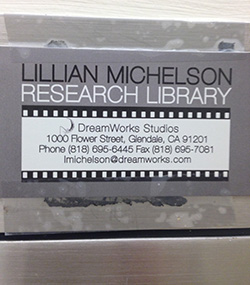 The library would move a few more times–to Paramount and, most prominently, under Lillian’s care, via Jeffrey Katzenberg to Dreamworks Animation Studios in Glendale.
The library would move a few more times–to Paramount and, most prominently, under Lillian’s care, via Jeffrey Katzenberg to Dreamworks Animation Studios in Glendale.
During their lives together, Harold and Lillian worked on the films of all of our lives: Ben Hur, West Side Story, The Apartment, Chinatown, Rosemary’s Baby, Terms of Endearment and on and on. As their boys grew into men, with prospering lives of their own, Harold and Lillian quietly became known, through their mentorship and giving back, the heart and soul of the best of what Hollywood can be. The very definition of invaluable behind-the-scenes contributors–and true Hollywood royalty.
Sweetly, in 2004, Dreamworks Animation (who’d lent office space to the couple to continue work at their ripe young age) made a sequel to their greatest success and, let’s just say, there’s no coincidence Princess Fiona’s parents in Shrek 2 are named King Harold and Queen Lillian. There they were–on screen–the orphan girl and the prince of Miami, ruling over their own fairy tale kingdom, just as it should be.
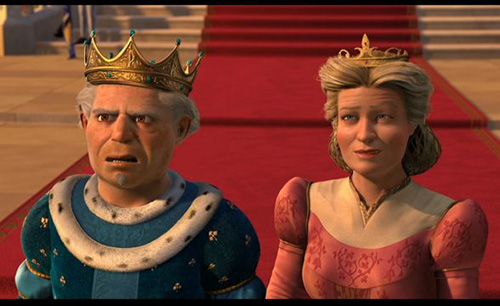
In 2007, after two trips to the Academy Awards as a nominee, after a full and rich family life, Lillian finally needed to bring Harold to Long-Term Care at MPTF where, after a struggle with severe dementia–he passed away. Shortly afterwards, Lillian became a resident and she is known by pretty much everyone there, stylish as ever–and always with a smile or a wave for her many friends. Lillian lives on the third floor at the Wasserman campus at MPTF. Out her window is an expanse of rolling farmland–some 80 acres or so that the MPTF purchased years ago that Lillian refers to as her “French countryside.” She says it’s so nice to let the breeze come in and just sit, surveying the view–much the way her husband did throughout his life.
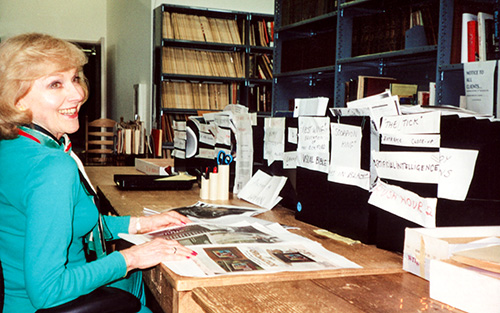
It’s here that she is frequently visited by her boys. And that ever-sharp mind of hers is filled to the brim with her own stories now–of two lives living out one love story while helping to create great stories for the whole world to see that will live on and on. This is what the MPTF can do. This what the MPTF does. After years of helping to bring the world thousands of indelible movie moments, MPTF can give back–with safe care and a safe home where you can look out and gain even greater perspective. I’m sure Lillian would want to say a heartfelt thank you, but tonight–Lillian and Harold, who I’m sure is watching from his own unique viewpoint–on behalf of MPTF, and all of us across the world whose lives you’ve enriched, we ask that you please accept our humble bow–to the King and the Queen.
Back to Reel Stories, Real Lives

